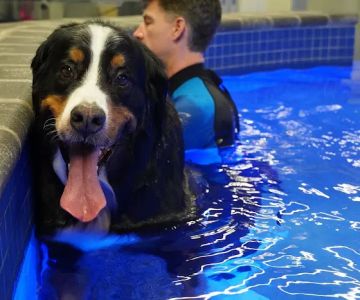- why-dogs-jump-on-people-explained
- the-behavioral-science-behind-the-jumping
- common-scenarios-and-what-your-dog-might-be-saying
- vet-approved-methods-to-correct-jumping-behavior
- when-to-seek-help-and-how-hidden-brook-veterinary-can-support-you
1. Why Dogs Jump on People: Explained
Jumping is one of the most common dog behaviors that frustrates pet owners—especially when guests come over or someone is dressed in clean clothes. But for dogs, jumping is often a misunderstood form of communication. It’s a natural way for them to greet, show excitement, or get your attention. Puppies instinctively jump up to lick their mother's face, and the behavior carries into adulthood if not addressed.
Unfortunately, while it may start out as adorable in a young pup, it quickly becomes problematic as the dog grows larger or stronger. That’s why understanding the “why” is the first step to positive, long-term correction.
2. The Behavioral Science Behind the Jumping
2.1 Attention-Seeking Behavior
Dogs learn quickly that jumping often results in interaction—even if it’s negative, like being pushed down or scolded. From a behavioral science standpoint, any attention (positive or negative) reinforces the behavior unless corrected correctly. That’s why jumping continues unless the attention is removed and redirected.
2.2 Overexcitement and Lack of Impulse Control
Some dogs, especially high-energy breeds like Labradors or Boxers, simply can’t contain their excitement. They haven’t yet developed impulse control—a skill that must be taught consistently over time. The trigger could be a visitor, their leash, or even a returning family member.
2.3 Learned Habits From Puppyhood
Many dog owners unintentionally encourage jumping when their dogs are small. Puppies jumping up is often met with affection and laughter. However, once the dog weighs 60 pounds, the same behavior isn’t so charming. Dogs don’t automatically “grow out of it”—they grow into what they’re taught.
3. Common Scenarios and What Your Dog Might Be Saying
Let’s look at a few real-world examples that illustrate how the context of the jump can point to the reason:
3.1 Greeting at the Door
When guests arrive and your dog jumps enthusiastically, it’s typically driven by excitement. They’re saying, “I’m so happy to see you!” It’s a greeting ritual—but not one humans appreciate.
3.2 Jumping on Children
Small children often squeal or run when dogs approach, which can escalate jumping behavior. In these cases, the dog may interpret the reaction as play behavior and become even more energetic.
3.3 Jumping After Ignored Cues
If your dog first tries nudging or pawing you and those gestures are ignored, jumping might be their escalation to say, “Hey, look at me!”—especially if it’s worked in the past.
4. Vet-Approved Methods to Correct Jumping Behavior
Correcting jumping involves training, consistency, and a dose of patience. Here are proven techniques endorsed by professionals:
4.1 Ignore, Don’t Engage
When your dog jumps, turn your back and avoid eye contact or speaking. The key is removing the reward—your attention. Once all four paws are on the ground, calmly offer praise or a treat.
4.2 Teach “Sit” or “Off” as a Default Behavior
Redirecting your dog to an alternate behavior like “sit” allows them to earn attention in an appropriate way. Practice this consistently during greetings, using treats and calm praise.
4.3 Manage the Environment
Use baby gates, leashes, or crates to limit your dog’s access to guests or high-trigger situations. This helps manage behavior while training is in progress.
4.4 Reinforce with Positive Training Tools
Clicker training, reward-based games, and structured playtimes help build the skills your dog needs. The goal isn’t to suppress their energy, but to channel it constructively.
5. When to Seek Help and How Hidden Brook Veterinary Can Support You
In some cases, persistent jumping is linked to underlying anxiety or behavioral disorders that require more than basic training. If your dog continues to jump despite consistent efforts, or if the behavior escalates into nipping or barking, professional insight is essential.
At Hidden Brook Veterinary, we work closely with pet parents to evaluate both physical and behavioral aspects of canine conduct. Our team can help identify whether jumping is linked to unmet needs—like a lack of physical exercise, attention, or confidence—and provide a plan that includes both veterinary assessment and tailored training referrals.
From puppy classes to adult dog behavior consultations, Hidden Brook Veterinary is committed to building better bonds between you and your dog—starting with understanding and correcting jumping behavior the right way.












